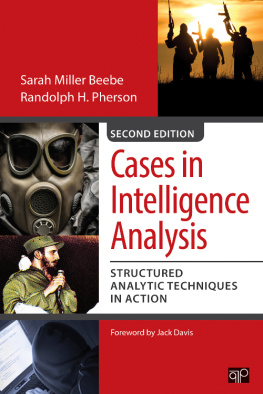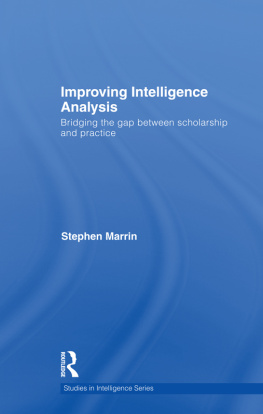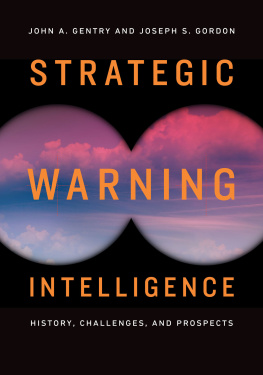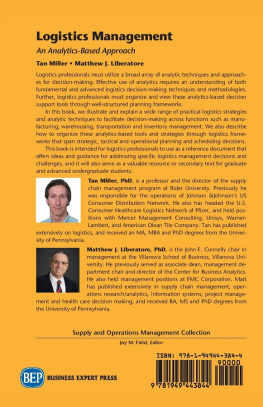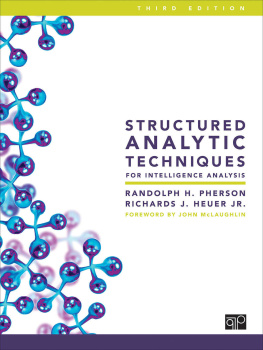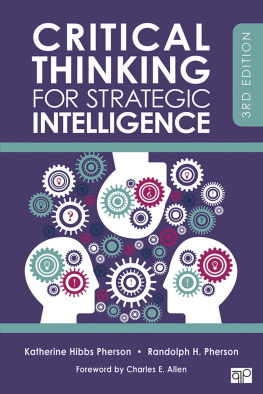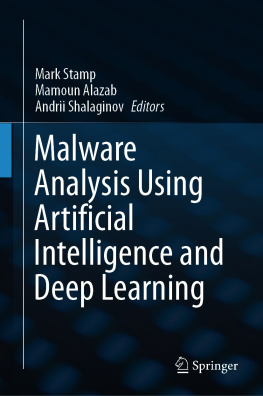Sarah Miller Beebe - Cases in Intelligence Analysis: Structured Analytic Techniques in Action
Here you can read online Sarah Miller Beebe - Cases in Intelligence Analysis: Structured Analytic Techniques in Action full text of the book (entire story) in english for free. Download pdf and epub, get meaning, cover and reviews about this ebook. year: 2015, publisher: SAGE Publications, Inc., genre: Politics. Description of the work, (preface) as well as reviews are available. Best literature library LitArk.com created for fans of good reading and offers a wide selection of genres:
Romance novel
Science fiction
Adventure
Detective
Science
History
Home and family
Prose
Art
Politics
Computer
Non-fiction
Religion
Business
Children
Humor
Choose a favorite category and find really read worthwhile books. Enjoy immersion in the world of imagination, feel the emotions of the characters or learn something new for yourself, make an fascinating discovery.
- Book:Cases in Intelligence Analysis: Structured Analytic Techniques in Action
- Author:
- Publisher:SAGE Publications, Inc.
- Genre:
- Year:2015
- Rating:3 / 5
- Favourites:Add to favourites
- Your mark:
- 60
- 1
- 2
- 3
- 4
- 5
Cases in Intelligence Analysis: Structured Analytic Techniques in Action: summary, description and annotation
We offer to read an annotation, description, summary or preface (depends on what the author of the book "Cases in Intelligence Analysis: Structured Analytic Techniques in Action" wrote himself). If you haven't found the necessary information about the book — write in the comments, we will try to find it.
Cases in Intelligence Analysis: Structured Analytic Techniques in Action — read online for free the complete book (whole text) full work
Below is the text of the book, divided by pages. System saving the place of the last page read, allows you to conveniently read the book "Cases in Intelligence Analysis: Structured Analytic Techniques in Action" online for free, without having to search again every time where you left off. Put a bookmark, and you can go to the page where you finished reading at any time.
Font size:
Interval:
Bookmark:

About the Authors
Sarah Miller Beebe began thinking about a book of cases during her career as an analyst and manager at the Central Intelligence Agency. A variety of broadening experiences, including an assignment as director for Russia on the National Security Council staff and a position as a national counterintelligence officer at the Office of the National Counterintelligence Executive, drove home the need for rigorous and effective approaches to intelligence analysis. It became apparent to her that cases could not only teach important analytic lessons surrounding historical events but also give analysts experience using a question-based thinking approach underpinned by practical techniques to improve their analyses. Now, as owner of Ascendant Analytics, she helps organizations apply such techniques against their specific analytic problems.
Randolph H. Pherson has spearheaded teaching and developing analytic techniques and critical thinking skills in the Intelligence Community. He is the author of the Handbook of Analytic Tools and Techniques and has coauthored Structured Analytic Techniques for Intelligence Analysis with Richards J. Heuer Jr., Critical Thinking for Strategic Intelligence with Katherine Hibbs Pherson, and the Analytic Writing Guide with Louis M. Kaiser. Throughout his twenty-eight-year career at the Central Intelligence Agency, where he last served as national intelligence officer for Latin America, he was an avid supporter of ways to instill more rigor in the analytic process. As president of Pherson Associates, LLC since 2003 and chief executive officer of Globalytica, LLC since 2009, he has been a vigorous proponent of a case-based approach to analytic instruction.
Together, Beebe and Pherson have developed and tested new analytic tools and techniques, created interactive analytic tradecraft courses, and facilitated analytic projects. In their work as analytic coaches, facilitators, and instructors, they have found the case approach to be an invaluable teaching tool. This second edition of case studies is their most recent collaboration and one that they hope will help analysts of all types improve both the quality and impact of their work.
Annotated Contents
| BY JACK DAVIS, CIA TRAILBLAZER |
| BY ROBERT JERVIS, COLUMBIA UNIVERSITY |
| The poisoning of prominent Russian human rights lawyer Karinna Moskalenko captured worldwide media attention in the fall of 2008. It was regarded as yet another entry in a growing list of poisonings and assassinations allegedly carried out by Russias government against its critics at home and abroad. This case employs the Premortem Analysis, Structured Self-Critique, and Starbursting techniques to help analysts examine the facts of this fast-moving story and develop a robust set of questions to guide a nuanced analysis of the case. |
| On 15 October 2001, a fine white substance poured out of a letter opened by an intern in Sen. Tom Daschles office on Capitol Hill. By the end of the day the white powder was confirmed to be a deadly dose of anthrax. Over the ensuing weeks, cases of anthrax emerged in Connecticut, Florida, Washington, D.C., New Jersey, and New York. The incident riveted the attention of the nation: Who could be behind the attack, and how far might it spread? In this case Chronologies frame the problem and bring order to the jumble of data points; Timelines put key facts and events in context; and a Premortem Analysis and Structured Self-Critique help illuminate important areas for further consideration by developing alternative explanations, challenging assumptions, identifying biases, and closely examining the evidentiary base. |
| On 8 November 2011 at the Curran-Gardner Public Water District just outside Springfield, Illinois, a large water pump repeatedly and spontaneously powered on and off. It was as if someone was repeatedly flipping an on/off switch. Although the pump had been behaving strangely for two or three months, it had never turned on and off repeatedly. By the end of the day the pump burned out, leaving it unusable. Utility officials were flummoxed. Who or what had caused the pump failure? The Getting Started Checklist, Key Assumptions Check, and Devils Advocacy are quick and effective techniques that help analysts focus on the relevant questions, consider alternative outcomes, reveal unsupported assumptions, and troubleshoot their final analysis. |
| In 1999, the New York Times reported that China had used stolen US nuclear secrets to make rapid advances in its nuclear warhead development. Given the small community of US scientists with access to such data, investigators quickly focused their case on Taiwanese American nuclear scientist Wen Ho Lee. Had Wen Ho Lee engaged in undetected nefarious activities for decades, or did the government narrow its gaze too quickly? Analysts use the Force Field Analysis, Deception Detection, Premortem Analysis, and Structured Self-Critique techniques to evaluate both sides of the case, test for deception, and troubleshoot the governments position that Wen Ho Lee was a spy. |
| By the time Ronald Reagan became president in 1981, the United States and Cuba had been engaged in diplomatic, economic, and armed conflict since Fidel Castro came to power in 1959. During its first year, the Reagan administration announced plans to begin broadcasting news of Cuba to Cubans from a radio station in Florida. The hope was that the radio broadcasts would challenge the Cuban regimes control of information on the island. It would also be part of the administrations strategy of directly confronting Cubaan ally of the Soviet Union. |
| When Radio Martinamed after Cuban writer and national revolutionary hero Jose Martibegan broadcasting in May 1985, its low-key opening words Buenos dias, Cuba did not reflect the four years of uncertainty within the US government about how Cuba would respond to broadcasts from a radio station intended as another American challenge to the Castro regime. Those four years would involve sophisticated Cuban efforts to influence the US political process. Both countries would engage in threats and make counterthreats. The full range of intelligence collection and analysis including open source, human, and technical collection efforts would be employed. Cuba would conduct sophisticated counterintelligence measures. Finally, the United States would respond by developing a comprehensive set of countermeasures enabled by its technical and military capabilities should the Cubans retaliate when Radio Marti eventually started to broadcast. This case study applies Chronologies and Timelines, Deception Detection, Quadrant Hypotheses Generation, and Analysis of Competing Hypotheses to track the tactical moves and strategies employed by both countries and assess whether events were leading up to a radio war with Cuba. |
| The US military in 2005 faced a pivotal decision about building a paved road through a Taliban stronghold to Tarin Kowt, a provincial capital in Afghanistan. The United States and other international donors saw the road as a critical element in efforts to stabilize, modernize, and democratize Afghanistan. With Afghanistans first parliamentary elections since the overthrow of the Taliban on the horizon, the US Army considered embarking on a highly accelerated schedule to complete the road in time for the election. This case uses the Key Assumptions Check, Devils Advocacy, and Strengths-Weaknesses-Opportunities-Threats techniques to structure a thorough assessment of the operating environment, the probable enemy response, and the potential impact on broader US goals for Afghanistan. |
Font size:
Interval:
Bookmark:
Similar books «Cases in Intelligence Analysis: Structured Analytic Techniques in Action»
Look at similar books to Cases in Intelligence Analysis: Structured Analytic Techniques in Action. We have selected literature similar in name and meaning in the hope of providing readers with more options to find new, interesting, not yet read works.
Discussion, reviews of the book Cases in Intelligence Analysis: Structured Analytic Techniques in Action and just readers' own opinions. Leave your comments, write what you think about the work, its meaning or the main characters. Specify what exactly you liked and what you didn't like, and why you think so.

